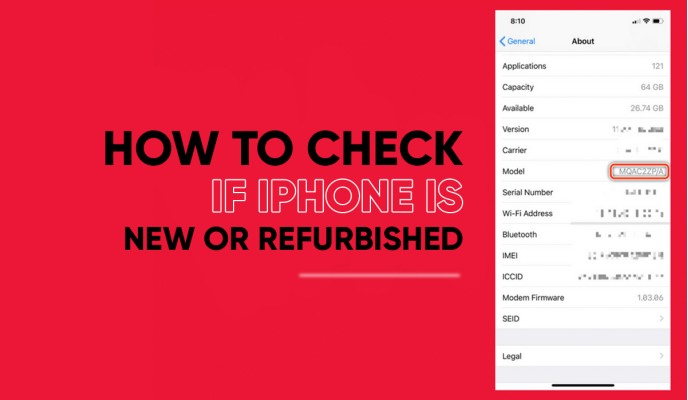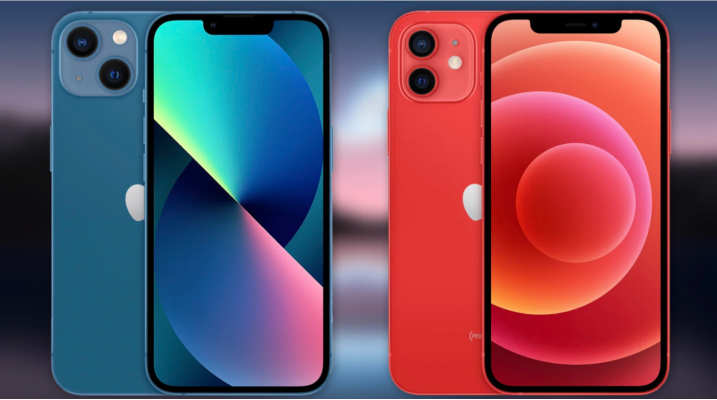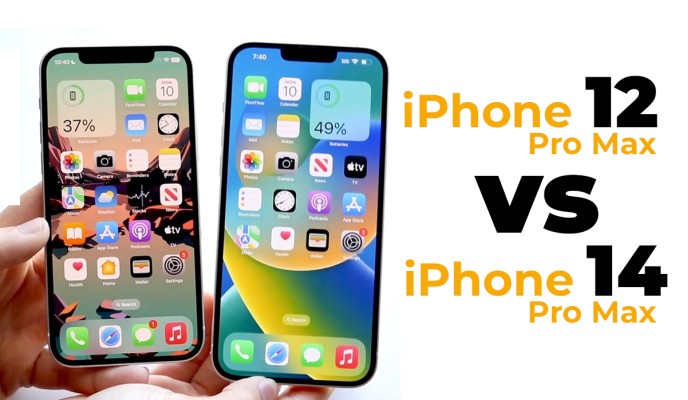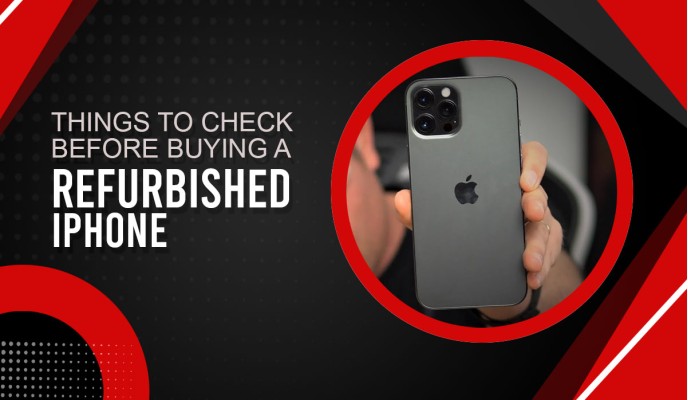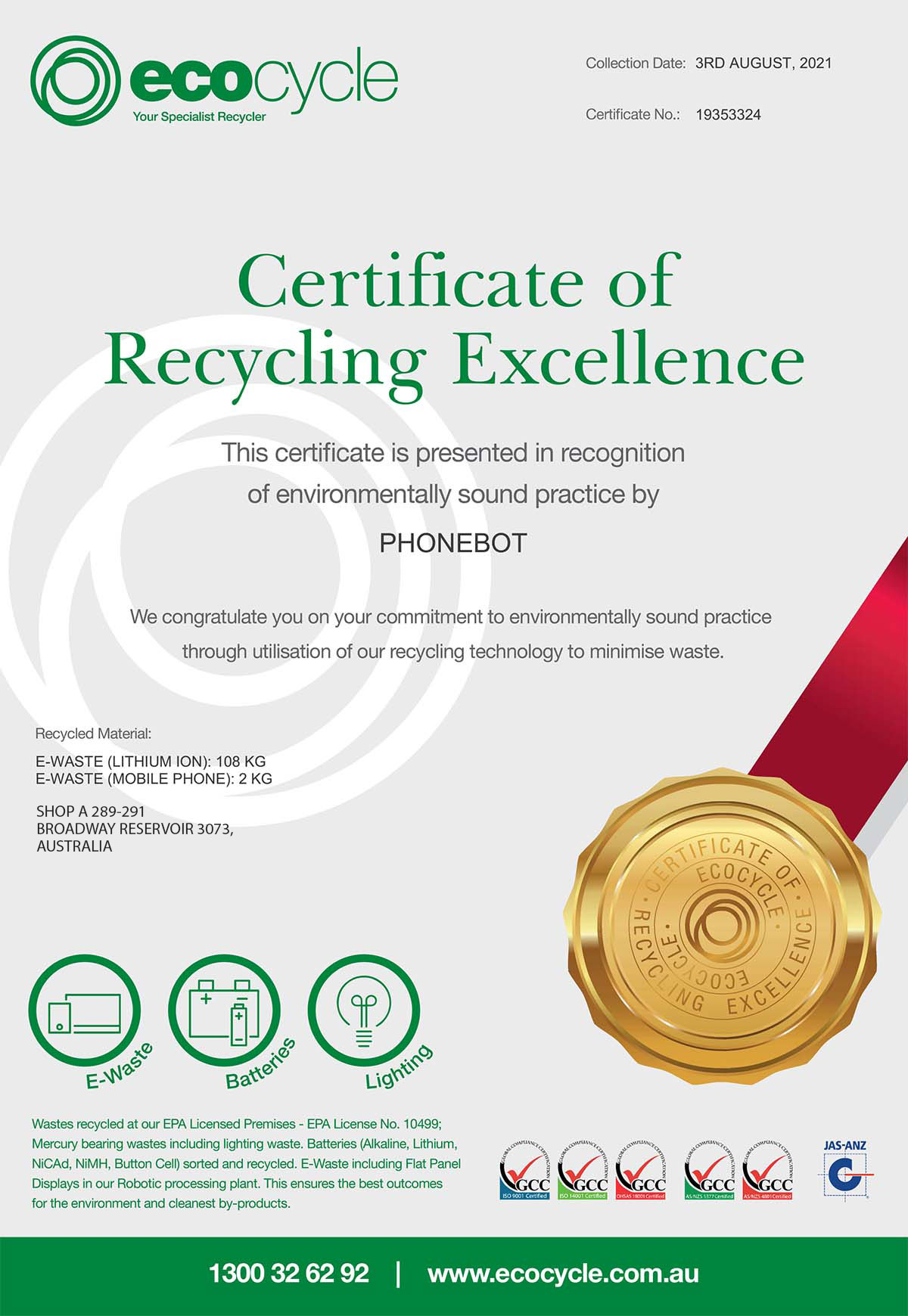iPhone 13 vs. iPhone 14 - A Closer Look at Apple's Evolution
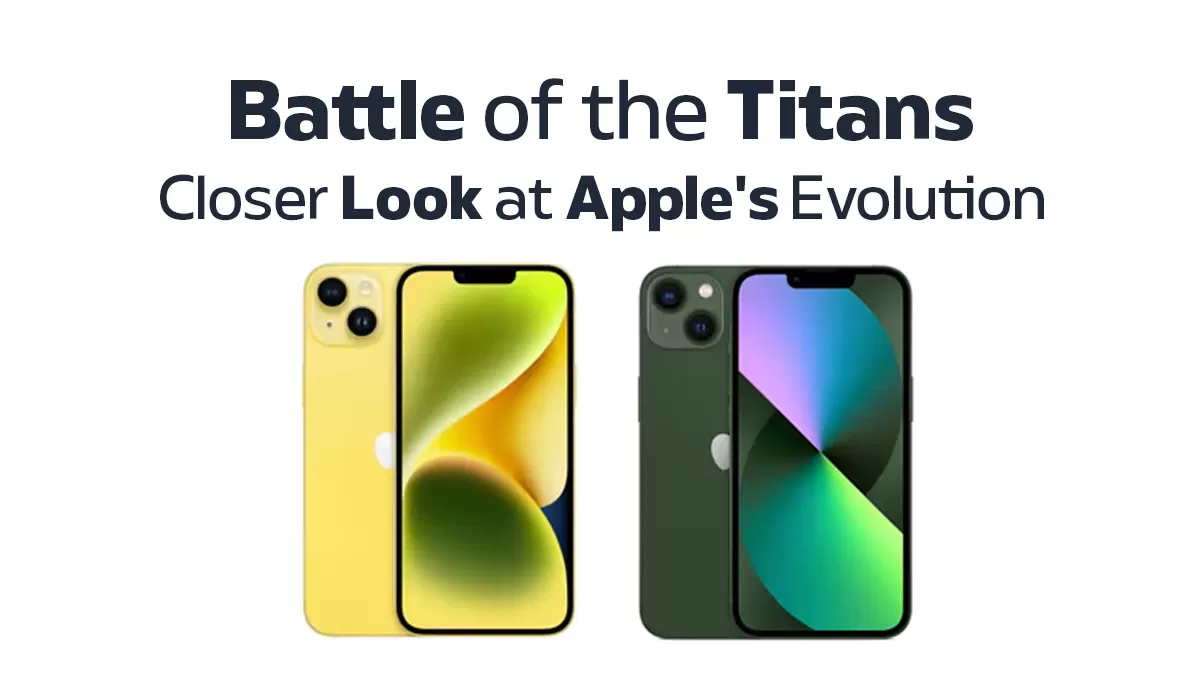
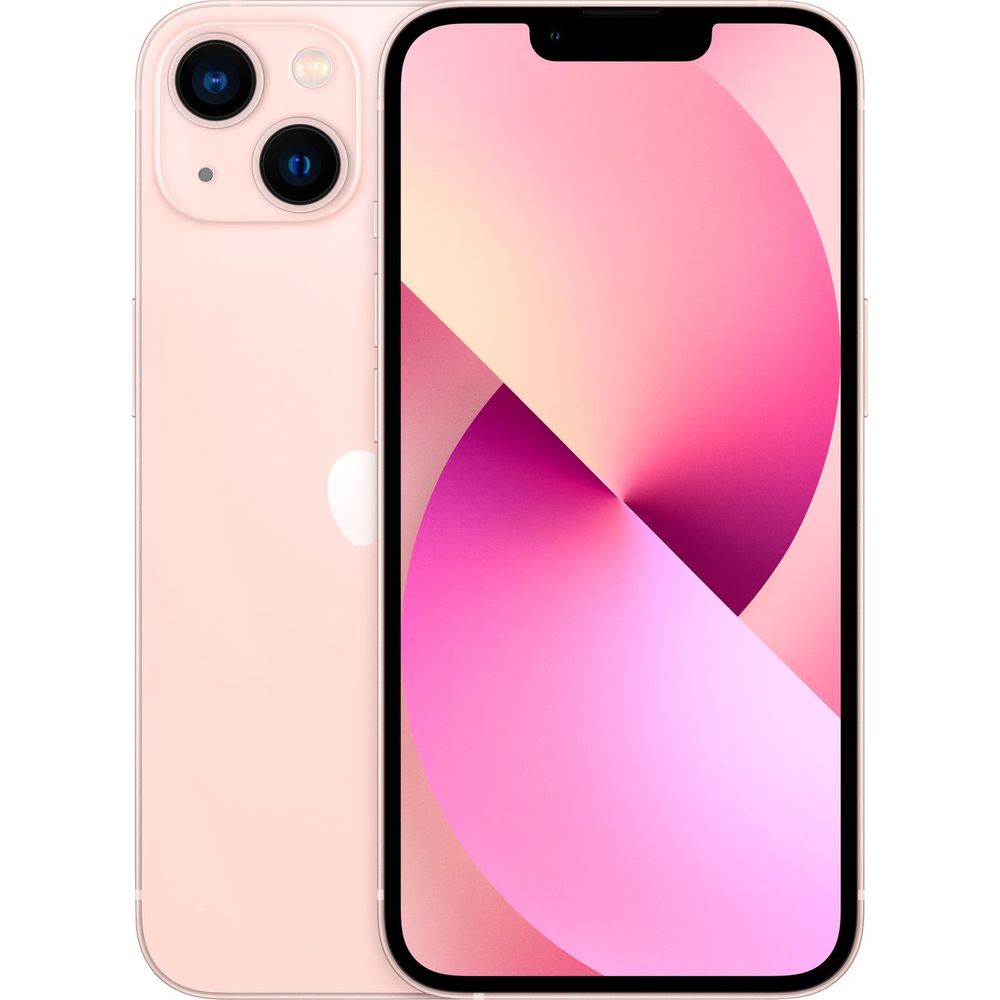
4-core GPU (A15 Bionic)
4GB of memory
Bluetooth 5.0
Dual-camera system
12-megapixel Main camera with ƒ/1.6 aperture
12-megapixel front-facing camera with ƒ/2.2 aperture
Cinematic mode for recording videos with shallow depth of field (1080p at 30 fps)
Up to 19 hours battery life during video playback
Thickness of 7.65mm
Weighs 174 grams
eSIM optional
Emergency SOS
Available in Green, Pink, Blue, Midnight, Starlight, and PRODUCT(RED)

5-core GPU (A15 Bionic)
6GB of memory
Bluetooth 5.3
"Advanced" dual-camera system
12-megapixel Main camera with ƒ/1.5 aperture and larger sensor
12-megapixel front-facing camera with ƒ/1.9 aperture and autofocus
Photonic Engine
Cinematic mode for recording videos with shallow depth of field (4K HDR up to 30 fps)
Action mode
Up to 20 hours battery life during video playback
Thickness of 7.80mm
Weighs 172 grams
eSIM only (in the U.S.)
Emergency SOS via satellite
Crash Detection
Available in Blue, Purple, Midnight, Starlight, and PRODUCT(RED)
In one corner, we have the iPhone 14, Apple's latest and greatest flagship smartphone. And in the other corner, we have the older yet powerful iPhone 13, one of the best-value iPhones. It's time to compare these two titans and see which one is on top.
Will the iPhone 14's new features and advancements be enough to dethrone its predecessor? Or will the iPhone 13 prove that sometimes, the old guard still reigns supreme? We'll let the results answer these questions.
Get ready for a clash of the iPhones as we dive into the nitty-gritty details of the iPhone 13 vs. 14 battle.
iPhone 13 vs. 14: Specs
Specifications | iPhone 13 | iPhone 14 |
Screen Size | 6.1" | 6.1" |
Screen Resolution | 1170 x 2532 pixels | 1170 x 2532 pixels |
Display Technology | Super Retina XDR OLED | Super Retina XDR OLED |
Processor | A15 Bionic | A15 Bionic |
CPU | 6-cores | 6-cores |
GPU | 4-cores | 5-cores |
Rear Cameras | wide: 12 MP, f/1.6 ultrawide: 12 MP, f/2.4 | wide: 12 MP, f/1.5 ultrawide: 12 MP, f/2.4 Action Mode |
Selfie Camera | 12 MP, f/2.2 | 12 MP, f/1.9 Cinematic Mode, and Autofocus |
Battery life | up to 19 hours of video playback | up to 20 hours of video playback |
Durability | IP68 dust/water resistant (up to 6m for 30 min) | IP68 dust/water resistant (up to 6m for 30 min) |
Colours | Starlight, Midnight, Blue, Pink, Red, Green | Midnight, Purple, Starlight, Blue, Red, Yellow |
Dimensions | 146.7 x 71.5 x 7.7 mm | 146.7 x 71.5 x 7.8 mm |
Weight | 174 g | 172 g |
iPhone 14 vs. 13: Price
On Apple's website, the iPhone 13 sells for a starting price of A$1229 for the 128GB model. Meanwhile, the iPhone 14 starts at A$1399 for the same storage capacity.
However, PhoneBot offers even more enticing prices. The price for a refurbished iPhone 14 starts at A$1299, while the refurbished Phone 13 price starts at A$939.
This presents an excellent opportunity for those seeking a cheap iPhone 14 or a more affordable second-hand iPhone 13 without compromising quality.
iPhone 13 vs. iPhone 14: Design
Starting with the design, the iPhone 13 and iPhone 14 have the same overall look.
On the front, you'll find an edge-to-edge display on both phones. Moving to the back, the refurbished iPhone 13 and iPhone 14 feature a glossy finish that you can personalize with your choice of color.
Regarding durability, they share the same IP68 rating for water, dust, and splash resistance. So, accidental encounters with these elements won't cause harm for the most part.
In terms of dimensions, the refurbished iPhone 14 is very similar to the iPhone 13. While the height and width remain the same, the iPhone 14 is slightly thicker, likely due to accommodating a slightly larger battery. But the difference is so minor that iPhone 13 covers can work as covers for iPhone 14.
On the other hand, the iPhone 14 shares the same notch design and size as its predecessor, the iPhone 13.
Plus, both these phones are backed by a Ceramic Shield front, Corning-made glass back, and aerospace-grade aluminum frame at the sides for toughness.
Lastly, the same diagonal dual camera setup is at the back of both phones, neatly boxed in a square at the top left. The dual lenses are of the same size, round and big, and the flash placement is also the same.
In short, the iPhone 13 vs. 14 design difference comes down to dimensions only, with the iPhone 14 being slightly thicker (7.7 vs. 7.8 mm) and slightly heavier (172 vs. 174 g).
iPhone 13 vs iPhone 14: Display
If you were expecting a spicy iPhone 13 vs 14 display battle, you're out of luck, as Apple has maintained identical displays for both models.
Both models come with a 6.1-inch Super Retina XDR OLED screen featuring a resolution of 1170 x 2532 and Apple's Ceramic Shield cover glass for added durability.
In terms of refresh rate, both the iPhone 13 and iPhone 14 stick to the standard 60Hz, which means you won't get the super-smooth 120Hz experience found in the Pro versions of the iPhone 13.
While this may be disappointing for those craving that extra fluidity, it's important to remember that a 60Hz refresh rate is still perfectly adequate for most day-to-day activities.
The iPhone 13 and iPhone 14 have HDR support, a True Tone display, and 800 typical and 1200 peak brightness for visual quality.
iPhone 14 vs. iPhone 13: Durability and Rating
Apple has given identical durability features to iPhone 14 and iPhone 13.
Both models feature Apple's Ceramic Shield glass on the front, which provides excellent scratch resistance and helps minimize the chances of damage from accidental drops. They both have an IP68 rating for dust and water resistance, meaning they can be submerged in up to 6 meters of water for 30 minutes and come out unfazed.
But you should still be wary of always taking it to water activities as this resistance is temporary and may decay with time.
Whether you choose the iPhone 14 or iPhone 13, you can trust that they will hold up well under typical usage scenarios. That being said, it's important to remember that no phone is entirely immune to damage, and accidents can happen.
To maximize the durability of your iPhone 14 or iPhone 13, you should go for a quality protective case that adds an extra layer of defense against drops, bumps, and scratches.
If you fear your iPhone can still face accidental damages, you can buy AppleCare, Apple's warranty program. Our AppleCare guide gives a deeper understanding of how this program works.
In conclusion, the durability comparison of the iPhone 13 vs. the iPhone 14 has no differences.
iPhone 13 vs. 14: Cameras
The iPhone 13 vs. 14 camera comparison makes you think the real improvements lie in the camera department. The range of new features and subtle changes across all cameras of the iPhone 14 makes it one of the top camera phones of 2024 for camera enthusiasts.
Here are the changes made to the back and front cameras:
Back Camera:
[iPhone 14’s back camera]
The iPhone 14 introduces a 12MP primary camera with a wider ƒ/1.5 aperture, allowing more light to enter and improving low-light performance.
Meanwhile, the iPhone 13 features a 12MP main camera with a slightly narrower ƒ/1.6 aperture. While it still captures excellent photos, the narrower aperture may result in slightly reduced low-light performance compared to the iPhone 14.
[iPhone 13’s back camera]
Regarding the ultrawide sensor, both have the same 12 MP configuration with an equal ƒ/2.4 aperture.
The iPhone 14 also introduces the innovative Photonic Engine, a new camera feature that significantly enhances image quality in low-light conditions.
It is said to significantly increase the ultrawide lens quality, while the primary and TrueDepth cameras will also deliver improved results. This advanced technology works seamlessly across all cameras within the iPhone 14.
The iPhone 14 and iPhone 13 incorporate sensor-shift optical image stabilization (OIS), ensuring sharper images and reducing the impact of camera shake.
While both phones have night mode, the iPhone 14's night mode will perform better as it builds upon the already impressive low-light capabilities, thanks to its wider aperture and enhanced processing with the photonic engine.
Front Camera:
For the first time, the iPhone 14 comes equipped with a 12MP front camera featuring an autofocus mechanism.
This advancement allows for sharper and more precise selfies. On the other hand, the iPhone 13 lacks the autofocus feature and sports a slightly narrower lens (f/2.2 vs. f/1.9) while having the same 12MP configuration.
The iPhone 14's front camera has another edge over the iPhone 13 in the form of Cinematic mode. This mode brings a cinema-grade touch to your videos, enabling depth-of-field effects and smooth focus transitions.
Difference between iPhone 13 vs. 14: Video recording
The iPhone 13 vs iPhone 14 camera faceoff reveals little differences. One change in iPhone 14's video capabilities is that now it can record 4K HDR videos at 30 fps using Cinematic mode.
Meanwhile, iPhone 13's Cinematic mode can only record 30 fps videos up to 1080p.
The iPhone 13 also lacks the dedicated Action mode, meaning capturing sports or other dynamic activities might result in slightly more motion blur than the iPhone 14.
Besides that, both phones' video recording gear remains the same. Here are some of the commonalities:
- HDR video recording with Dolby Vision up to 4K at 60 fps
- 4K video recording at 24 fps, 25 fps, 30 fps, or 60 fps
- 1080p HD video recording at 25 fps, 30 fps, or 60 fps
- 720p HD video recording at 30 fps
- Sensor-shift optical image stabilization for video
- Slo‑mo video support for 1080p at 120 fps or 240 fps
- Time‑lapse video with stabilization
- Cinematic video stabilization (4K, 1080p, and 720p)
- Continuous autofocus video
- Take 8MP still photos while recording 4K video
iPhone 14 vs. 13: Performance
Apple went against its tradition for the first time and didn't roll out a new processor with its new phone. So, both iPhones in question are powered by the A15 Bionic chip.
However, subtle changes still give an upper hand to the iPhone 14 over the iPhone 13's performance.
For instance, while the chip is the same in both, the version of the A15 Bionic chip in the iPhone 14 is the same powerful silicon found in the iPhone 13 Pro. This means the iPhone 14 features a 5-core GPU compared to the 4-core GPU in the iPhone 13.
Benchmark scores further illustrate the performance disparity between the two devices. In Geekbench 5, the iPhone 13 achieved single-core results of 1,684 and multi-core results of 4,192. On the other hand, the iPhone 14 demonstrated higher scores with single-core results of 1,727 and multi-core results of 4,553.
In 3DMark's WildLife Unlimited test, the iPhone 13 achieved 60 frames per second (fps). However, the iPhone 14 outshines its predecessor with a higher frame rate of 69 fps.
The GPU upgrade translates to enhanced gaming performance and smoother graphics on the iPhone 14. And the higher benchmark scores rank it in the best gaming phones ranking.
iPhone 13 vs. iPhone 14: Software
The iPhone 14 gets a jumpstart by launching with the latest iOS version, iOS 16, right out of the box. On the other hand, the iPhone 13 initially came with iOS 15, but given it's one of the latest iOS-compatible iPhones, You can update the iPhone 13 to iOS 16 to enjoy the same features as the iPhone 14.
With iOS 16, both the iPhone 14 and iPhone 13 benefit from exciting new software additions. This includes Lock screen customizations and the ability to edit and undo sent messages, making communication more flexible and convenient.
iPhone 14 also gets exclusive features like emergency calling via satellite and the force sensor for car crash detection, also present in the Apple Watch Series 8.
Regarding the number of iOS updates, Apple doesn't specify a fixed count for its products. However, based on historical trends, iPhones typically receive five to seven years of software support.
Considering the iPhone 14's launch in 2022, you can expect software updates until around 2028. Similarly, iPhone 13 may get software updates until 2027.
iPhone 14 vs. iPhone 13: Processor & GPU
The iPhone 14 and iPhone 13 are equipped with the powerful A15 Bionic chip. While the 6-core CPU consisting of 2 performance and 4 efficiency cores remains the same between the two devices, there is a notable difference in the GPU.
The iPhone 14 features a 5-core GPU, compared to the 4-core GPU in the iPhone 13. Given this enhancement, the iPhone 14 will exhibit subtle enhancements in GPU performance and deliver smoother graphics.
iPhone 13 vs. 14: Battery And Charging
The iPhone 13 vs. 14 battery comparison reveals battery capacity and life differences. The iPhone 14 has a slightly larger battery capacity of 3,279 mAh compared to the iPhone 13's 3,240 mAh battery.
A 3,279 mAh battery gives the iPhone 14 a slightly improved battery life, offering up to 20 hours of video playback and up to 80 hours of audio playback, compared to the iPhone 13's respective figures of up to 19 hours and up to 75 hours.
You can also make your iPhone last longer than this by following our battery-saving guide.
Both phones support MagSafe wireless charging up to 15W and Qi wireless charging up to 7.5W.
Apple introduced fast charging standards with the release of the iPhone 8. Therefore, both iPhones make it to the fast-charging phones list.
They can charge up to 50% in 30 minutes with a 20W adapter or higher, although you must purchase the charger separately.
Apple iPhone 14 vs. 13: Colours
Apple offers a range of vibrant colour options for both the iPhone 13 and iPhone 14. The list of colours available for both devices is the same. Have a look:
Apple iPhone 14 Colours
There are six iPhone 14 colours available for you to upgrade to the latest iPhone and Show off your style with a colorful upgrade.
- Midnight
- Purple
- Starlight
- (PRODUCT)RED
- Blue
- Yellow
Apple iPhone 13 Colours
Six different iPhone 13 colours are available to show off your style with a colorful new phone. Which color is your favorite from the following
- (PRODUCT)RED
- Starlight
- Midnight
- Blue
- Pink
- Green
iPhone 14 vs. 13: Pros & Cons
For | Against | |
iPhone 14 | New Action mode | The refresh rate remains the same 60Hz |
The cinematic mode can capture up to 4K | ||
Safety features including crash detection and emergency calling via satellite | Same notch as its predecessor | |
Additional GPU core | The same A15 Bionic chip as the last generation | |
Photonic engine for better low-light photos | ||
First iPhone with autofocus in the front camera | Still no telephoto lens | |
iPhone 13 | Same megapixels across all cameras as the newer iPhone. | Cinematic mode capped at 1080p |
4-core GPU against 5-cores of iPhone 14 | ||
No photonic engine | ||
Same powerful A15 Bionic chip | No Action mode | |
No Crash detection or emergency satellite calling | ||
No autofocus in the front camera |
While considering your upgrade options, it's also worth mentioning the benefits of refurbished iPhones.
These pre-owned devices, which have undergone meticulous refurbishment processes, offer a cost-effective alternative to brand-new iPhones.
By opting for a refurbished iPhone, you can enjoy the latest features and technology at a more affordable price point, making it an appealing choice for budget-conscious individuals
iPhone 13 vs. 14: Which Phone Should You Buy?
The iPhone 14 undoubtedly brings upgrades in emergency connectivity, crash detection, GPU performance, and improved low-light photography. However, these upgrades are still so minor that you'll barely feel any change in the performance of both phones.
So, if you're more budget-conscious, the cheaper iPhone 13 remains a solid choice. But if you want the Action mode and the enhancements that Photonic Engine brings, you can buy a second-hand iPhone 14 at budget rates, as it's a smarter choice than going for brand-new phones.
Our blog explains why you don't need to upgrade to a brand-new phone every year. Instead, refurbished phones are a much better option.
If you own an iPhone 13, upgrading to the iPhone 14 may not be necessary as the new features and enhancements are too few.
We don't see the new emergency SOS via satellite and crash detection features and other fractional changes worthy enough of ditching your iPhone 13 for buying a highly identical device for an even higher price.
But it all comes down to your budget and preferences.
If you want to upgrade, the higher-end models of the iPhone 13 lineup, like the iPhone 13 Pro Max or the latest iPhone 14 Pro Max, are more fit contenders.
Take advantage of our comparison between the 13 Pro Max and 14 Pro Max if you consider these choices.
Related Products
Frequently Asked Questions
For the most part, both iPhones are similar. However, Apple did introduce subtle improvements across the features of the iPhone 14.
These differences are more prominent in the GPU, camera, and software departments.
Yes, the iPhone 14 does a few things differently. For instance, it now captures up to 4K in cinematic mode. The camera also has a new action mode.
The new photonic engine also improves low-light photography while you click the picture. A new crash detection feature seeks medical help for you upon detecting a crash.
The iPhone 14's battery gives 20 hours of video playback and 16 hours of streamed video playback. The audio playback figure is 80 hours.
 Black Friday Picks
Black Friday Picks![Apple iPhone 14 Pro Max 5G (256GB) [Grade B] Apple iPhone 14 Pro Max 5G (256GB) [Grade B]](https://www.phonebot.com.au/image/cache/catalog/refurbished/apple/iphone-14/iphone-14-pro/apple-iphone-14-pro-purple-200x170.jpg)
![Apple iPhone 14 Plus 5G (256GB) [Like New] Apple iPhone 14 Plus 5G (256GB) [Like New]](https://www.phonebot.com.au/image/cache/catalog/refurbished/apple/iphone-14/iphone-14-plus/midnight-200x170.jpg)
![Apple iPhone 14 5G (128GB) [Grade A] Apple iPhone 14 5G (128GB) [Grade A]](https://www.phonebot.com.au/image/cache/catalog/refurbished/apple/iphone-14/iphone-14/blue-200x170.jpg)
![Apple iPhone 14 Pro 5G (256GB) [Grade B] Apple iPhone 14 Pro 5G (256GB) [Grade B]](https://www.phonebot.com.au/image/cache/catalog/refurbished/apple/iphone-14/iphone-14-pro/Iphone-14-pro-200x170.jpg)
